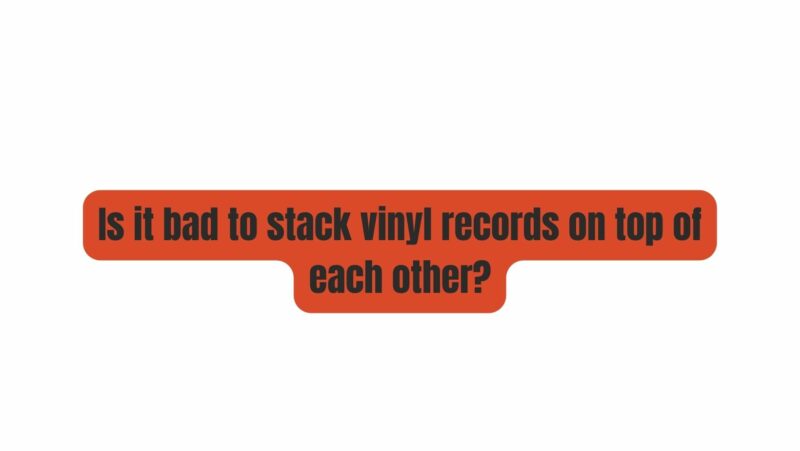In the midst of a vinyl resurgence, music enthusiasts and collectors alike are faced with the age-old question: Is it bad to stack vinyl records on top of each other? Vinyl records, with their warm analog sound and tactile appeal, have become prized possessions for many. However, the way you stack them can significantly impact their condition and audio quality. In this comprehensive guide, we will explore the practice of stacking vinyl records on top of each other, assess the potential risks and benefits, and provide practical tips to help you make informed decisions on how to store your vinyl collection while preserving its value and integrity.
Understanding the Composition of Vinyl Records
Before delving into the specifics of vinyl record stacking, it’s essential to understand the composition and fragility of these cherished analog audio artifacts.
- Vinyl Record Composition: Vinyl records are predominantly made of polyvinyl chloride (PVC), a durable and flexible plastic. The record itself is a flat, circular disc with grooves etched onto its surface to store audio information in the form of analog signals.
- Playback Process: Playing a vinyl record involves a stylus (needle) tracking the grooves as the record rotates on a turntable. The stylus converts the analog signals into audible sound waves, delivering the characteristic warmth and depth of vinyl audio.
The Impact of Stacking Vinyl Records on Top of Each Other
Stacking vinyl records on top of each other can be a practical solution for maximizing storage space and accessibility. However, it’s essential to be aware of the potential risks associated with this practice.
Potential Risks:
- Warping: Stacking records horizontally can exert uneven pressure on the vinyl, leading to warping over time. Warping results in a distorted shape of the record, making it unplayable or causing tracking issues during playback.
- Groove Damage: Vinyl records feature delicate grooves that store audio information. When records lean against each other or experience excessive pressure, it can lead to scratches or damage to the grooves, adversely affecting sound quality.
- Static Electricity: Stacks of records generate static electricity, which can attract dust and debris. This can result in dirty records and a gradual degradation of sound quality.
- Sleeve and Cover Damage: Stacking records without proper protection can cause wear and tear on album covers and sleeves, potentially affecting their condition and appearance.
- Difficult Retrieval: Retrieving a specific record from a stack can be challenging and increases the risk of accidental damage during handling.
Factors Influencing the Safety of Stacking Vinyl Records
The safety of stacking vinyl records on top of each other depends on several factors:
- Record Quality: The quality of the vinyl record itself plays a significant role. Higher-quality records may be less prone to warping and groove damage.
- Storage Conditions: The environment in which records are stored can impact their resilience. A stable temperature and humidity level are essential for preventing warping.
- Leaning Angle: The angle at which records lean against each other matters. A slight lean may have less impact than a steep angle.
- Support and Stability: The support and stability of the stacking structure or storage solution can affect the records. Sturdy dividers or bookends can help distribute pressure more evenly.
- Protective Sleeves: Using protective polyethylene or polypropylene sleeves can provide a protective barrier and reduce the risk of scratches and static buildup.
Best Practices for Storing Vinyl Records
While it is possible to stack vinyl records on top of each other, it is essential to follow best practices to minimize the associated risks:
- Vertical Storage Preferred: Whenever possible, store vinyl records vertically. This method involves storing records upright, much like books on a shelf. Vertical storage reduces the risk of warping and facilitates easy browsing.
- Use Protective Sleeves: Keep records in high-quality protective sleeves at all times. These sleeves shield records from dust, reduce static buildup, and provide a layer of protection against scratches.
- Avoid Overstacking: Resist the urge to stack too many records on top of each other. Excessive weight can lead to warping, especially when records are stacked horizontally. Limit your stacks to a reasonable height, typically no more than a few records high.
- Provide Adequate Support: When stacking records horizontally, use sturdy dividers or bookends to support the stack. This helps distribute the weight evenly and minimizes the risk of warping.
- Rotate Stacks Periodically: If you must stack records horizontally, periodically rotate the albums within the stack. This practice prevents warping caused by prolonged pressure on specific spots.
- Maintain a Stable Environment: Store your vinyl records in a stable, controlled environment to prevent warping due to temperature and humidity fluctuations. Ideal conditions include a temperature range of 60-70°F (15-21°C) and a relative humidity of 45-50%.
- Regular Inspection: Periodically inspect your collection for any signs of damage, warping, or dust accumulation. Address any issues promptly to prevent further deterioration.
- Invest in Quality Storage Solutions: Consider investing in quality storage solutions such as shelves, crates, or dedicated record storage units. These solutions are designed to accommodate vinyl records safely and efficiently.
Conclusion
In conclusion, the practice of stacking vinyl records on top of each other can be a practical storage solution, but it requires careful consideration and adherence to best practices to minimize potential risks. Storing records vertically is generally preferred to prevent warping and groove damage. Using protective sleeves, avoiding overstacking, providing adequate support, and maintaining a stable storage environment are crucial for preserving the condition and sound quality of your vinyl records.
Ultimately, the goal is to strike a balance between practical storage solutions and the preservation of your cherished vinyl collection. By following these guidelines, you can enjoy your vinyl records for years to come while preserving their unique sound and physical integrity. The decision to stack or not to stack is one that should be made with careful thought and consideration for the long-term well-being of your vinyl collection.


